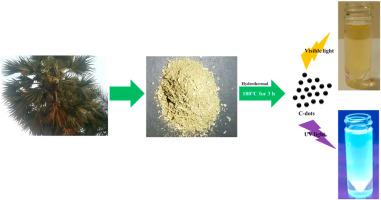Sustainable Chemistry and Pharmacy ( IF 5.5 ) Pub Date : 2020-10-18 , DOI: 10.1016/j.scp.2020.100334 Jegan Athinarayanan , Vaiyapuri Subbarayan Periasamy , Khalid A. Alatiah , Ali A. Alshatwi

|
A humble and environmental benign preparation of carbon nanodots (CDs) utilizing palmyra leaves as a sustainable precursor, by hydrothermal method, is reported. The morphology, structure, optical and thermal behavior of CDs was investigated using transmission electron microscopy, photoluminescence spectroscopy UV–Vis spectroscopy, X-ray diffractometer, Fourier transform infrared spectroscopy and thermogravimetric analysis. The fluorescent CDs have a spherical shape and size of around 5–10 nm. The TEM images suggest that crystallinity of the carbon nanodots with a lattice parameter of 0.238 nm, corresponding to the (100) diffraction facets of graphite. The synthesized CDs biocompatibility was assessed using the cell viability assay and acridine orange/ethidium bromide (AO/EB) dual staining in human mesenchymal stem cells (hMSCs). The cell viability assay results exhibit that CDs slightly decrease the human mesenchymal stem cells viability at high dose. However, no remarkable changes were observed in cell viability. Furthermore, we assessed the CDs influence on nuclear morphology of hMSCs. These results clearly suggest that CDs treated cells have healthy and intact nuclei. Overall, our study results revealed that CDs have excellent compatibility on cells. Thus, the synthesized CDs can be used as versatile fluorescent probe for cellular imaging because of their excitation-dependent emission. Furthermore, we utilize the CDs as fluorescent probe for cellular imaging using confocal microscope, resulting tunable fluorescent emission. The CDs can enter the cells and accumulate in cytoplasmic region, symptomatic of congenial potential for multicolor imaging.
中文翻译:

应用于多色成像的棕榈叶棕榈叶碳纳米点的合成和细胞相容性分析
据报道,通过水热法,利用棕榈叶作为可持续的前体,对碳纳米点(CD)进行了谦逊而环保的制备。使用透射电子显微镜,光致发光光谱,UV-Vis光谱,X射线衍射仪,傅立叶变换红外光谱和热重分析,研究了CD的形态,结构,光学和热行为。荧光CD呈球形,大小约为5-10 nm。TEM图像表明,晶格参数为0.238 nm的碳纳米点的结晶度,对应于石墨的(100)衍射面。使用细胞生存力测定法和ibility间充质干细胞(hMSCs)中的a啶橙/溴化乙锭(AO / EB)双重染色评估了合成的CDs的生物相容性。细胞活力测定结果表明,高剂量时CD会稍微降低人间充质干细胞的活力。但是,没有观察到细胞活力的显着变化。此外,我们评估了CD对hMSCs核形态的影响。这些结果清楚地表明,经CD处理的细胞具有健康且完整的细胞核。总体而言,我们的研究结果表明CD具有出色的细胞相容性。因此,合成的CD由于其激发依赖性发射,可以用作细胞成像的通用荧光探针。此外,我们利用CD作为共聚焦显微镜进行细胞成像的荧光探针,从而产生可调的荧光发射。CD可以进入细胞并积聚在细胞质区域,这是多色成像的先天潜力的征兆。











































 京公网安备 11010802027423号
京公网安备 11010802027423号